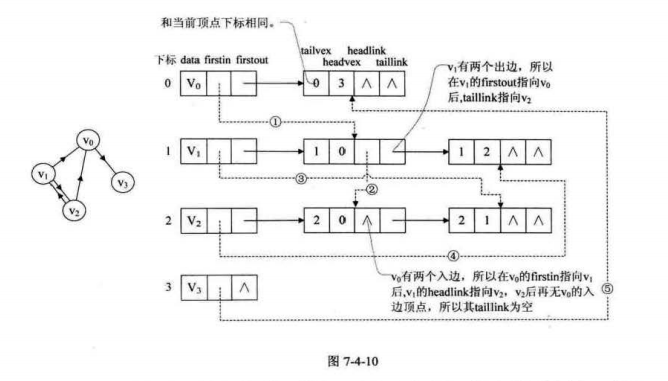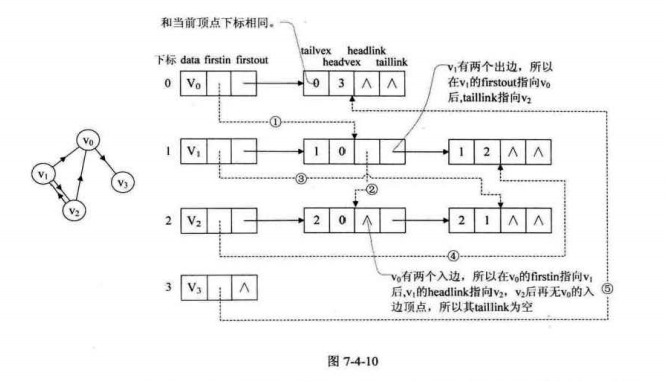我们想要知道出度方向的顶点,可以使用邻接表,我们要了解入度就需要使用逆邻接表。但是我们既想要了解入度有想要了解出度,那么我们该如何处理?
这时就需要使用到有向图的一种存储方法:十字链表
顶点表结点结构

firstin表示入边表头指针,指向该顶点的入边表中第一个结点。firstout表示出边表头指针,指向该顶点的出边表中第一个结点。
边表结点结构
tailvex是指弧起点在顶点表的下标headvex是指弧终点在顶点表的下标。headlink是指入边表指针域,指向终点相同的下一条边taillink是指边表指针域,指向起点相同的下一条边。如果是网,我们还要在其中加入权值域,来存储权值

我们可以看做横向是出度,竖向是入度顶点的出度和入度。除了结构复杂一点外,其实创建图算法的时间复杂度和邻接表是相同的,因此很好的应用在有向图中。注意:整张图的出度和入度是一致的(不是某个顶点,而是这张图)
代码实现:
//十字链表public class OrthogonalList {private int MAXVEX;private VertexNode[] verArr;// 顶点数组赋值public OrthogonalList(String[] arr) {this.MAXVEX = arr.length;this.verArr = new VertexNode[this.MAXVEX];for (int i = 0; i < arr.length; i++) {this.verArr[i] = new VertexNode(arr[i]);}}//获取顶点在顶点数组中的位置private int getPosition(String str) {int pos = 0;for(int i=0;i<this.MAXVEX;i++){if(this.verArr[i].getData().equals(str)){pos=i;break;}}return pos;}/*** 输入的是边数组* @param strArr*/public void addAdj(String[][] strArr) {for (int i = 0; i < strArr.length; i++) {//弧的起点在顶点数组中的下标int tailvex = getPosition(strArr[i][0]);//弧终点在顶点数组中的下标int headvex = getPosition(strArr[i][1]);//初始化边表邻接点EdgeNode adj = new EdgeNode();//设置位置开始位置adj.setTailvex(tailvex);//设置结束位置adj.setHeadvex(headvex);//获取开始节点的出边表邻接点EdgeNode firstout = this.verArr[tailvex].getFristout();//获取结束节点的入边表邻接点EdgeNode firstin = this.verArr[headvex].getFristin();//直接使用头插法this.verArr[tailvex].setFristout(adj);if (firstout != null) {adj.setTaillink(firstout);}/*** 尾插法//处理开始节点的出边表(邻接矩阵)if (firstout == null) {this.verArr[tailvex].setFristout(adj);} else {//这里是找到最后的出边表,其实可以放在第一个即可while (true) {if (firstout.getTaillink() != null) {firstout = firstout.getTaillink();} else {firstout.setTaillink(adj);break;}}}**///直接使用头插法this.verArr[headvex].setFristin(adj);if (firstin != null) {adj.setHeadlink(firstin);}/*** 尾插法//处理结束节点的入边表(逆邻接矩阵)if (firstin == null) {this.verArr[headvex].setFristin(adj);} else {//这里也可以在while (true) {if (firstin.getHeadlink() != null) {firstin = firstin.getHeadlink();} else {firstin.setHeadlink(adj);break;}}}**/}}/*** 获取入度* @param str* @return*/public int getIndegree(String str) {int i = 0;int pos=getPosition(str);EdgeNode temp = this.verArr[pos].getFristin();if (temp == null)return i;while (true) {if (temp != null) {i++;temp = temp.getHeadlink();} else {break;}}return i;}/*** 获取出度* @param str* @return*/public int getOutdegree(String str) {int i = 0;int pos=getPosition(str);EdgeNode temp = this.verArr[pos].getFristout();if (temp == null)return i;while (true) {if (temp != null) {i++;temp = temp.getTaillink();} else {break;}}return i;}public static void main(String[] args) {// TODO Auto-generated method stubString[] str={"v0","v1","v2","v3"};OrthogonalList adj=new OrthogonalList(str);String[][] edges=new String[][]{{"v0","v3"},{"v1","v0"},{"v1","v2"},{"v2","v0"},{"v2","v1"}};adj.addAdj(edges);//出度System.out.println(adj.getOutdegree("v1"));//入度System.out.println(adj.getIndegree("v0"));}}// 顶点表节点class VertexNode {private String data = null;private EdgeNode fristin = null;// 入边表(顶点为弧尾)private EdgeNode fristout = null;// 出边表(顶点为弧头)public VertexNode(String data) {super();this.data = data;}public String getData() {return data;}public void setData(String data) {this.data = data;}public EdgeNode getFristin() {return fristin;}public void setFristin(EdgeNode fristin) {this.fristin = fristin;}public EdgeNode getFristout() {return fristout;}public void setFristout(EdgeNode fristout) {this.fristout = fristout;}}//边表节点class EdgeNode {private int tailvex = -1;// 弧的起点在顶点数组中的下标private int headvex = -1;// 弧终点在顶点数组中的下标private EdgeNode headlink = null;// 指向下一个终点相同的邻接点private EdgeNode taillink = null;// 指向下一个起点相同的邻接点public int getTailvex() {return tailvex;}public void setTailvex(int tailvex) {this.tailvex = tailvex;}public int getHeadvex() {return headvex;}public void setHeadvex(int headvex) {this.headvex = headvex;}public EdgeNode getHeadlink() {return headlink;}public void setHeadlink(EdgeNode headlink) {this.headlink = headlink;}public EdgeNode getTaillink() {return taillink;}public void setTaillink(EdgeNode taillink) {this.taillink = taillink;}}
运行结果如下:
22








